
The trumpeter swan (Cygnus buccinator) is a species of swan found in North America. The heaviest living bird native to North America, it is also the largest extant species of waterfowl, with a wingspan of 185 to 250 cm (6 ft 2 in to 8 ft 2 in).[2] It is the American counterpart and a close relative of the whooper swan (Cygnus cygnus) of Eurasia, and even has been considered the same species by some authorities.[3] By 1933, fewer than 70 wild trumpeters were known to exist, and extinction seemed imminent, until aerial surveys discovered a Pacific population of several thousand trumpeters around Alaska's Copper River.[4] Careful reintroductions by wildlife agencies and the Trumpeter Swan Society gradually restored the North American wild population to over 46,000 birds by 2010.[5]
Description
The trumpeter swan is the largest extant species of waterfowl, and both the heaviest and longest native bird of North America. Adults usually measure 138–165 cm (4 ft 6 in – 5 ft 5 in) long, though large males can exceed 180 cm (5 ft 11 in) in total length.[2][7][8][9] The weight of adult birds is typically 7–13.6 kg (15–30 lb). Possibly due to seasonal variation based on food access and variability due to age, average weights in males have been reported to range from 10.9 to 12.7 kg (24 to 28 lb) and from 9.4 to 10.3 kg (21 to 23 lb) in females.[2][10][11][12] It is one of the heaviest living birds or animals capable of flight, and, in terms of average mass, the heaviest flying bird in the world. Alongside the mute swan (Cygnus olor), Dalmatian pelican (Pelecanus crispus), kori bustard (Ardeotis kori), and Andean condor (Vultur gryphus), it is one of a handful to weigh in excess of 10 kg (22 lb) between the sexes, and one survey of wintering trumpeters found it averaged second only to the condor in mean mass.[13][14] The trumpeter swan's wingspan ranges from 185 to 250 cm (6 ft 1 in to 8 ft 2 in), with the wing chord measuring 60–68 cm (24–27 in).[2][7][8][15] The largest known male trumpeter attained a length of 183 cm (6 ft 0 in), a wingspan of 3.1 m (10 ft 2 in) and a weight of 17.2 kg (38 lb). It is the second heaviest wild waterfowl ever found, as one mute swan was found to weigh a massive 23 kg (51 lb), but it was unclear whether the latter swan was still capable of flight because of its bulk.[16]
The adult trumpeter swan's plumage is entirely white. Like mute swan cygnets, the cygnets of the trumpeter swan have light grey plumage and pinkish legs, gaining their white plumage after about a year. As with the whooper swan, this species has upright posture and generally swims with a straight neck. The trumpeter swan has a large, wedge-shaped black bill that can, in some cases, be minimally lined with salmon-pink coloration around the mouth. The bill, measuring 10.5–12 cm (4.1–4.7 in), is up to twice the length of a Canada goose's (Branta canadensis) bill and is the largest of any waterfowl. The legs are gray-pink in color, though in some birds can appear yellowish gray to even black. The tarsus measures 10.5–12 cm (4.1–4.7 in). The mute swan, introduced to North America, is scarcely smaller. However, it can easily be distinguished by its orange bill and different physical structure (particularly the neck, which is typically held curved as opposed to straight in the trumpeter). The mute swan is often found year-around in developed areas near human habitation in North America, whereas trumpeters are usually only found in pristine wetlands with minimal human disturbance, especially while breeding.[2] The tundra swan (C. columbianus) more closely resembles the trumpeter, but is significantly smaller. The neck of a male trumpeter may be twice as long as the neck of a tundra swan.[2] The tundra swan can be further distinguished by its yellow lores. However, some trumpeter swans have yellow lores; many of these individuals appear to be leucistic and have paler legs than typical trumpeters.[17] Distinguishing tundra and trumpeter swans from a distance (when size is harder to gauge) can be challenging without direct comparison but it is possible thanks to the trumpeter's obviously longer neck (the great length of which is apparent even when the swan is not standing or swimming upright) and larger, wedge-shaped bill as compared to the tundra swan.
Trumpeter swans have similar calls to whooper swans and Bewick's swans. They are loud and somewhat musical creatures, with their cry sounding similar to a trumpet, which gave the bird its name.
Range and habitat
Beginning in 1968, repeated in 1975, and then conducted at 5-year intervals, a cooperative continental survey of trumpeter swans was last conducted in 2015.[5] The survey assesses trumpeter swan abundance and productivity throughout the entire breeding ranges of the three recognized North American populations: the Pacific Coast (PCP), Rocky Mountain (RMP), and Interior (IP) populations (see Figure). From 1968 to 2010 the population has increased from 3,722 to approximately 46,225 birds, in large part due to re-introductions to its historic range.[5]
Their breeding habitat is large shallow ponds, undisturbed lakes, pristine wetlands and wide slow rivers, and marshes in northwestern and central North America, with the largest numbers of breeding pairs found in Alaska. They prefer nesting sites with enough space for them to have enough surface water for them to take off, as well as accessible food, shallow, unpolluted water, and little or no human disturbance.[18] Natural populations of these swans migrate to and from the Pacific coast and portions of the United States, flying in V-shaped flocks. Released populations are mostly non-migratory.
In the winter, they migrate to the southern tier of Canada, the eastern part of the northwest states in the United States, especially to the Red Rock Lakes area of Montana, the north Puget Sound region of northwest Washington state;[19] they have even been observed as far south as Pagosa Springs, Colorado. Historically, they ranged as far south as Texas and southern California.[20] In addition, there is a specimen in the Museum of Comparative Zoology in Cambridge, Massachusetts, that was shot by F. B. Armstrong in 1909 at Matamoros, Tamaulipas, Mexico.[21] Since 1992, trumpeter swans have been found in Arkansas each November – February on Magness Lake outside of Heber Springs.[22] In early 2017, a juvenile trumpeter swan took up residence in the French Broad River in Asheville, North Carolina, marking the first such sighting in that part of the state.[23]
Non-migratory trumpeter swans have also been artificially introduced to some areas of Oregon, where they never originally occurred. Because of their natural beauty, they are suitable water fowl to attract bird watchers and other wildlife enthusiasts. Introductions of non-indigenous species in the Western states, for example through the Oregon Trumpeter Swan Program (OTSP), have also been met with criticism, but the introduction program argues that the perceived attractiveness of natural sites has priority over the original range of any given species.[24]
Occasional sightings of trumpeter swans have occurred in the United Kingdom;[25] while some of these are believed to be vagrants, most are presumed escapes into the wild. A single instance of the species breeding in the United Kingdom is reported from 1997, where two swans out of a group that escaped from a wildfowl collection at Apethorpe Palace, Northamptonshire raised a single cygnet on the River Nene.[26]
Diet
These birds feed while swimming, sometimes up-ending or dabbling to reach submerged food. The diet is almost entirely aquatic plants. They will eat both the leaves and stems of submerged and emergent vegetation. They will also dig into muddy substrate underwater to extract roots and tubers. In winter, they may also eat grasses and grains in fields. They will often feed at night as well as by day. Feeding activity, and the birds' weights, often peaks in the spring as they prepare for the breeding season.[27] The young initially include insects, small fish, fish eggs and small crustaceans in their diet, providing additional protein, and change to a vegetation-based diet over the first few months.
Breeding
Like other swans, trumpeter swans often mate for life, and both parents participate in raising their young, but primarily the female incubates the eggs. Most pair bonds are formed when swans are 5 to 7 years old, although some pairs do not form until they are nearly 20 years old. "Divorces" have been known between birds, in which case the mates will be serially monogamous, with mates in differing breeding seasons. Occasionally, if his mate dies, a male trumpeter swan may not pair again for the rest of his life.[18] Most egg laying occurs between late April and May. The female lays 3–12 eggs, with 4 to 6 being average, in a mound of plant material on a small island, a beaver or muskrat lodge, or a floating platform on a clump of emergent vegetation. The same location may be used for several years and both members of the pair help build the nest.[18] The nest consists of a large, open bowl of grasses, sedges and various aquatic vegetation and have ranged in diameter from 1.2 to 3.6 m (3.9 to 11.8 ft), the latter after repeated uses.[28] The eggs average 73 millimetres (2.9 in) wide, 113.5 millimetres (4.5 in) long, and weigh about 320 grams (11.3 oz).[18] The eggs are quite possibly the largest of any flying bird alive today, in comparison they are about 20% larger in dimensions and mass than those of an Andean condor (Vultur gryphus), which attains similar average adult weights, and more than twice as heavy as those of kori bustards (Ardeotis kori).[29][30][31] The incubation period is 32 to 37 days, handled mainly by the female, although occasionally by the male as well. The young are able to swim within two days and usually are capable of feeding themselves after, at most, two weeks. The fledging stage is reached at roughly 3 to 4 months.[32] While nesting, trumpeter swans are territorial and harass other animals, including conspecifics, who enter the area of their nest.[18]
Though the range of the two species does not overlap, the trumpeter swan can hybridise with its close relative, the whooper swan, and hybrid birds have been observed in the wild, most likely as a result of interbreeding between wild trumpeter and vagrant or introduced whooper swans.[33][34]
Adults go through a summer moult when they temporarily lose their flight feathers. The females become flightless shortly after the young hatch; the males go through this process about a month later when the females have completed their moult.
Mortality
In captivity, members of this species have survived to 33 years old and, in the wild, have lived to at least 24 years. Young trumpeter swans may have as little as 40% chance of survival due variously to disturbance and destruction by humans, predation, nest flooding, and starvation. In some areas, though, the breeding success rate is considerably greater and, occasionally, all cygnets may reach maturity. Mortality in adults is quite low, with the survival rate usually being 80–100% annually, unless they are hunted by humans.[35] Predators of trumpeter swan eggs include common ravens (Corvus corax), common raccoons (Procyon lotor), wolverines (Gulo gulo), American black bears (Ursus americanus), grizzly bears (Ursus arctos horribilis), coyotes (Canis latrans), gray wolves (Canis lupus), mountain lions (Puma concolor), and North American river otters (Lontra canadensis).[36][37][38][39][40][41][42] Nest location can provide partial protection from most mammalian nest predators, especially if placed on islands or floating vegetation in deep waters. Most of the same predators will prey on young cygnets, as will common snapping turtles (Chelhydra serpentina), California gulls (Larus californicus), great horned owls (Bubo virginianus), red foxes (Vulpes vulpes) and American mink (Neogale vison).[37][39][43][44][45][46] Larger cygnets and, rarely, nesting adults may be ambushed by golden eagles (Aquila chrysaetos), bobcats (Lynx rufus), and probably both coyotes and gray wolves.[44][46][47] When their eggs and young are threatened, the parents can be quite aggressive, initially displaying with head bobbing and hissing. If this is not sufficient, the adults will physically combat the predator, battering with their powerful wings and biting with their large bills; adults have managed to kill predators equal to their own weight in confrontations.[48][49] Predation of adults when they are not nesting is rare; they may possibly be hunted by golden and bald eagles, but substantiated cases are few. Photos of an exceptional attack by a bald eagle (Haliaeetus leucocephalus) on adult trumpeter swan in flight were taken in 2008, although the swan survived the predation attempt.[50]
Conservation status
Near extinction and rediscovery in Alaska
In the 19th and early 20th centuries, the trumpeter swan was hunted heavily, for game or meat, for the soft swanskins used in powder puffs, and for their quills and feathers. This species is also unusually sensitive to lead poisoning from ingesting discarded lead shot from fishing weights while young. The Hudson's Bay Company captured thousands of swans annually with a total of 17,671 swans killed between 1853 and 1877. In 1908 Edward Preble wrote of the decline in the hunt with the number sold annually dropping from 1,312 in 1854 to 122 in 1877.[51] Sir John Richardson wrote in 1831 that the trumpeter "is the most common Swan in the interior of the fur-counties... It is to the trumpeter that the bulk of the Swan-skins imported by the Hudson's Bay Company belong."[52] By the early twentieth century breeding trumpeter swans were nearly extirpated in the United States, with a remnant population of fewer than 70 wild trumpeters in remote hot springs in or near Yellowstone National Park. Surprising news came from a 1950s aerial survey of Alaska's Copper River when several thousand trumpeters were discovered.[4] This population provided critical genetic stock to complement the tri-state (Montana/Idaho/Wyoming) population for re-introductions in other parts of the swan's historic range.
Historical range
In 1918 Joseph Grinnell wrote that trumpeter swans once bred in North America from northwestern Indiana west to Oregon in the U.S., and in Canada from James Bay to the Yukon, and they migrated as far south as Texas and southern California.[20] In 1960 Winston E. Banko also placed their breeding range as far south as Nebraska, Missouri, Illinois, northwestern Indiana, but in Michigan turned this line northwards, placing a hypothetical eastern boundary up through Ontario to western Quebec and the eastern shore of James Bay.[39] In 1984, Harry G. Lumsden posited that trumpeter swans may have been extirpated from eastern Canada by native people armed with firearms prior to the arrival of European explorers and noted archaeological remains of trumpeter swans as far east as Port au Choix, Newfoundland dating to 2,000 BCE. He cited historical observer records of what must have been breeding trumpeters, such as Father Hennepin's August report of swans on the Detroit River from Lake St. Clair to Lake Erie in 1679 and Antoine de la Mothe Cadillac's 1701 report of summering swans (July 23 – October 8) in the same area: "There are such large numbers of swans that the rushes among which they are massed might be taken for lilies."[53] In the eastern United States the breeding range is potentially extended to North Carolina by the detailed report of John Lawson (1701) that "Of the swans we have two sorts, the one we call Trompeters...These are the largest sort we have...when spring comes on they go the Lakes to breed" versus "The sort of Swans called Hoopers; are the least."[54]
Reintroduction
Early efforts to reintroduce this bird into other parts of its original range, and to introduce it elsewhere, have had modest success, as suitable habitats have dwindled and the released birds do not undertake migrations. More recently, the population in all three major population regions have shown sustained growth over the past thirty-year period. Data from the US Fish and Wildlife Service[55] show 400% growth in that period, with signs of increasing growth rates over time.
One impediment to the growth of the trumpeter swan population around the Great Lakes is the presence of a growing non-native Eurasian mute swan population who compete for habitat.[7][56]
Alberta

One of the largest conservation sites for the trumpeter swan is located in Lois Hole Provincial Park. It is located adjacent to the renamed Trumpeter subdivision of Edmonton, Alberta, within Big Lake.
Michigan

Joe Johnson, a biologist for the W.K. Kellogg Bird Sanctuary, part of Michigan State University’s Kellogg Biological Station, obtained trumpeter swans from Alaska for re-introduction to Michigan beginning in 1986. The population has grown via continued re-introductions and organic growth to 756 birds by 2015. The native swans have benefited from removal of non-native mute swans by the Michigan Department of Natural Resources beginning in the 1960s, with a decline from 15,000 mute swans in 2010 to 8,700 in 2015.[57]
Minnesota
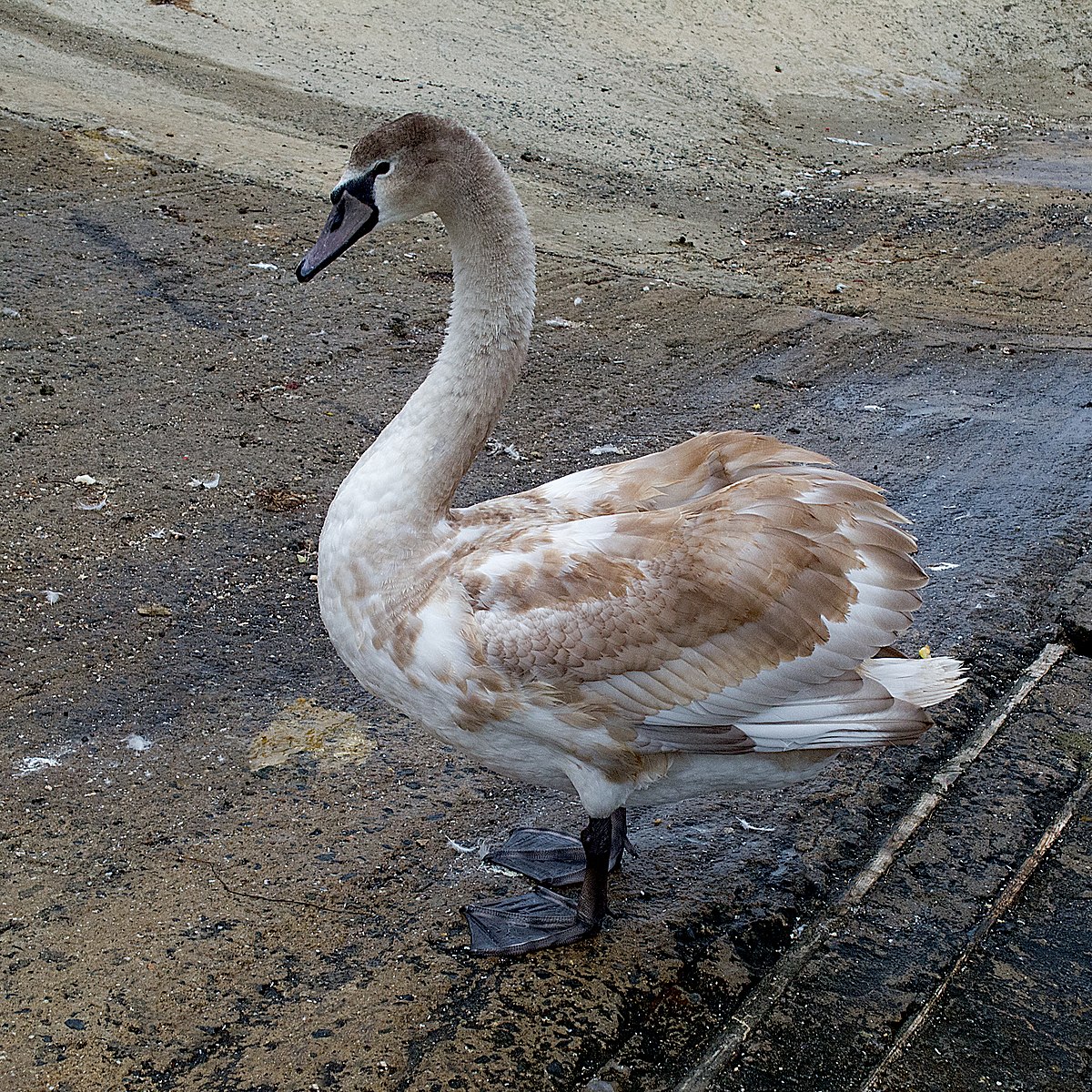
As of 2013, the trumpeter swan is no longer listed as threatened in the state of Minnesota.[58] In the winter months, a large population of trumpeter swans can be seen in the city of Monticello, Minnesota. [59]
Ontario
The Ontario Trumpeter Swan Restoration Group started a conservation project in 1982, using eggs collected in the wild. Live birds have also been taken from the wild. Since then, 584 birds have been released in Ontario. Despite lead poisoning in the wild from shotgun pellets, the prospects for restoration are considered optimistic.[60]
Yellowstone National Park
As of 2018, only two pairs of swans allegedly remained in the park. They have not bred in years. Scientists attribute the loss in the park's population to the loss of nests and nesting sites because of spring flooding caused by climate change. [61]
Mating Behaviour
Courtship and Mate choice Behaviours

In late April, breeding pairs meet to begin the 11 to 35 day process of constructing a nest. Before this grueling process can come to be, much like many other species of birds, these creatures undergo several courtship rituals.[62] Trumpeter Swans have a strong tendency to avoid interactions with conspecifics, therefore it is implied that at first contact of a potential mating pair there is some unwillingness in the male and female to make this connection.[63] In order to overcome the initial encounter there are two common displays that can occur. At first, the male tends to pursue the female in a non aggressive way. When the female allows the approach the male will touch the breast of its body to the flank of the female which then causes both individuals the touch the beasts of their bodies together.[63] At this point the feathers on the neck of the make is stood up and the bills of the mating pair are pointed down indicating pacification. Another act of courtship occurs when a male swims in the direction of a possible mate and continuously turns its head from side to side to get the attention or perhaps impress the female.[63] Other common behavioural displays presented by the pair include spreading and raising their wings, the rapid or almost quivering motion of the wings, particular head motions that include bobbing, and finally the most known (and what the name of this animal originates) is the trumpeting that occurs.[64] Acoustic communication among Trumpeter Swans is incredibly common among all ages of the species. From the young cygnets to the adult swans, their calls are incredibly distinct and have a wide variety of functions in the survival of the animal. The classic Trumpet call can be heard from long distances and is the most common communication mechanism heard among these birds. This type of call resembles a horn because the frequency can vary greatly. This call generally occurs when an animal is alarmed or feels threatened, the call acts as a warning or even a way in deterring incoming predators due to the abrupt volume of the noise being evoked.[64] More specifically referring to mating, the call that is most common among mating pairs is called the duet. This call happens when a pair has come together near breeding season. The duetting process can begin as separate trumpeting solos and can evolve into an almost simultaneous duet that is very similar in frequency and very difficult to tell the individual calls apart.[65] This performance of the pair is commonly associated with the particular movements mentioned above (head bobbing and wing movements) associated with the courtship. Also, the duet can aid in coordination of a duel attack on a predator that is too close to the nest of a mated pair.[65] In terms of mate choice, the Trumpeter swan continuously returns to the mate from previous breeding terms, often the breeding pair will even return to their previous breeding grounds if previous offspring were successful in that area.[66]
Nesting and Incubation Behaviour

The fabrication of a nest is an incredibly precise process that takes place over a series of 11 to 35 days and typically breeding pairs will begin construction in late April.[67] The time of year the nest-building process begins can slightly vary due to weather conditions in the previous year, if the environment was more cold and wet the females may not be heathy enough to being mating right away and as a result the nesting behaviour might be slightly delayed. It is common to find nests of trumpeter swans surrounded by water or close to water. This is advantageous to the parents because it can reduce the risk of predation, it can provide optimal foraging sources such as aquatic vegetation as well as ensuring there is nearby water for when the cygnets are hatched.[67] The long duration of the nest building process is predominantly due to the nest being so large (1.2 to 3.6m in diameter) and fabricated mainly from submerged vegetation as well as grasses and grass-like plants.[67] The nest is mostly constructed by the male while the female of the breeding pair is focused on feeding and preparing for the arrival of the cygnets. It has been observed that adult Trumpeter swans do not directly bring the building materials directly to the nest building site. The males use a specific action that includes facing away from the nest and throwing organic materials over their shoulder moving closer and closer to the nesting area[68].Eventually when they arrive at the nesting site the two individuals of the mating pair are involved in the construction, but, as mentioned above the male spends the majority of its time doing the construction. During nest construction, female Trumpeter swans feed significantly more frequently than males in order to fuel up for laying the eggs.[69] This is greatly supported by the male counterpart of the species because ultimately if the female is keeping itself healthy it will in the end ensure healthy offspring which improves the fitness of the mating pair. Typically a female Trumpeter swan will lay four to six eggs and will incubate them for 32 to 37 days until they hatch.[70] After the eggs are laid it is the female that spends the majority of the time incubating, it has been observed that around every 20 minutes the female will stand up from incubating and reach down beneath itself to roll over the eggs with its bill before re assuming the incubation position.[71] It can be inferred that this behaviour is used to ensure the eggs are kept an appropriate temperature on all sides, this is very important because exposure to the elements leads to high mortality rates in cygnets. The female only leaves the incubation process for brief recesses that last around 20 minutes. Before the female leaves for the recess it will cover the eggs with plant material and it has been observed that if the females does not cover the eggs the male will do so in the absence of the female.[72] This time away from the nest is primarily used for feeding, but the female has also been observed using this time for bathing and preening.[73] The only other time the female leaves the nest is when it must help the male chase away predators from their nesting territory.[74] It is highly uncommon for both members of a mating pair to be absent from the nest at the same time, there is generally always a male or a female present guarding the eggs.[75] The behavior of the male during and after the laying of the eggs can be best described as on alert. This is due to males being increasingly territorial and aggressive, particularly when a predator or conspecifics approach the nesting area.[74] Generally when females leave the nest during their brief recesses the males will stand and guard the eggs, although in some cases the males would even sit on the eggs in the absence of a female swan.[75]
Parental Behaviour

In the Trumpeter Swan there is a very clear division of labor between male and female parts of a breeding pair. This division is referring to clear roles that each parent knows to accomplish in the process leading up to, during, and after the mating process.
Males

After the meeting of the pair prior to mating or nest building the male will often initiate courting calls which results in the duet mentioned above. Before and throughout the laying period the male can be found dealing with construction of the nest and collection of resources. As the eggs are being incubated by the female the male does not feed or sleep as often particularly when the female left the nest. These trends also were associated with more aggressive behaviors from the male especially towards predators and other members of the species.[76] When it comes to parental behaviour, the male has already completed the majority of its role. With this in mind, the male does continue to be territorial and protective of the newly developing cygnets as well as allowing the female to replenish its nutrient reserves. This makes migration to wintering grounds possible and allows for more years of breeding.[76] Keeping the female of the mating pair healthy is important for Trumpeter swans because this species tends to only have one mate in its lifetime. A healthy female also improves the likelihood of having more successful clutches are well as better nesting experiences.[76] When cygnets are young it is common to see the male accompanying them in feeding recesses outside the nest.[77] This can fall under the category of the main male role in parenting being the protection of the offspring.
Females
The increased care and attention of the male to the young allowed for the female to feed more frequently and exert more energy toward protection and overall health to the developing cygnets.[78] During the pre-laying/laying period the males are significantly more active than the females of the breeding pair. This is advantageous in because it aids in the fitness of the species by improving reproductive success by allowing the female, as mentioned above, to feed more frequently and overall replenish the energy stored in order to aid in incubation and other crucial activities.[78] When hatching occurs the females tend to not leave the nest, the only time a female may leave would be to chase away a nearby predator.[79] After hatching the cygnets are brooded for the first one to two days by the female, cygnets are also brooded when needed (when it is cold or at night) for the first few weeks of their lives.[80] Young offspring have a very close relationship with their parents in the first part of their lives spending the majority of their first few weeks with the female in the nest or in the water.[79] Offspring tend to spend their first full winter with their parents and then they no longer need them.[80]
See also
- Grande Prairie, Alberta, Canada – The "Swan City" is located in an important trumpeter swan breeding area, and several pairs usually nest in urban parks
- Ralph Edwards, a leading Canadian conservationist of trumpeter swans
- The Trumpet of the Swan, a 1970 children's novel by E. B. White.

Cygnus buccinator

Geographical distribution of Trumpeter swan. Breeding Year-round Nonbreeding


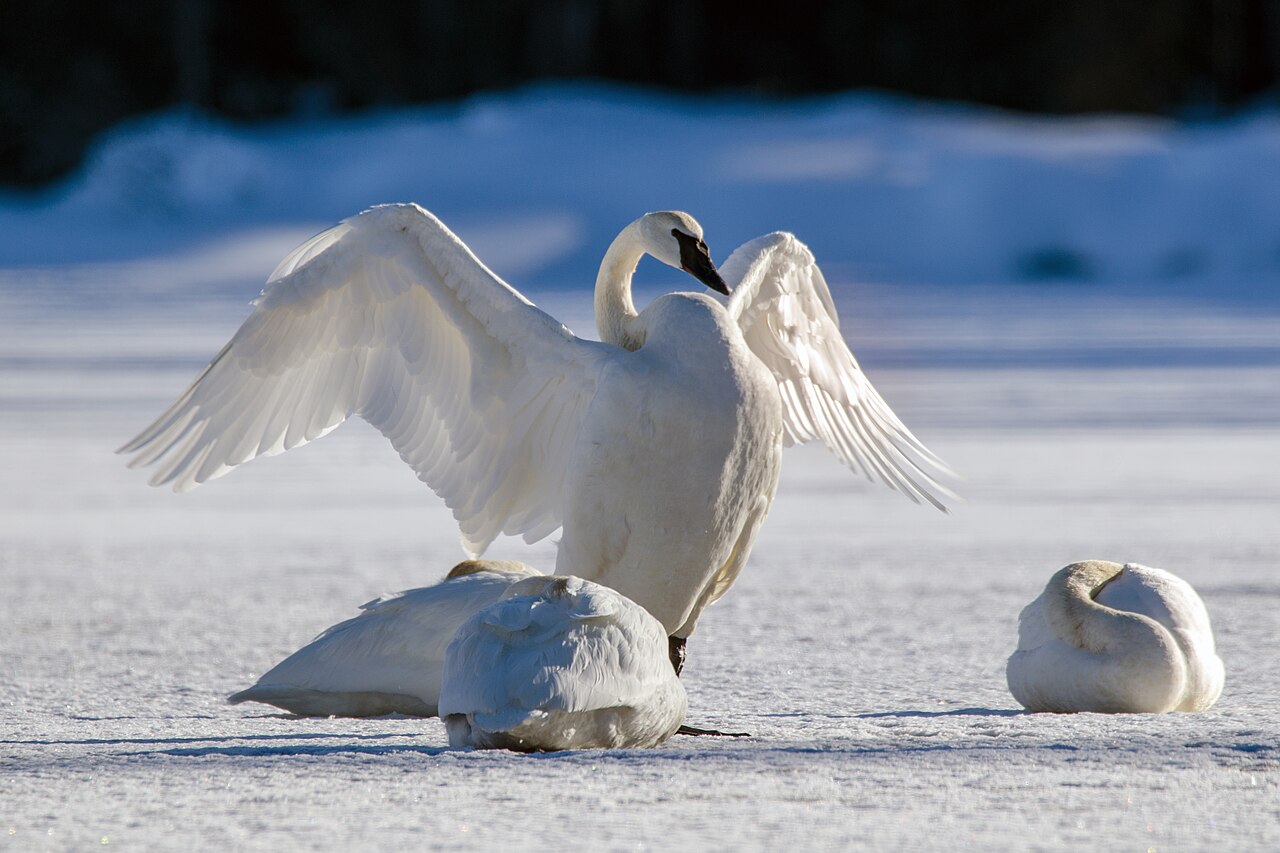



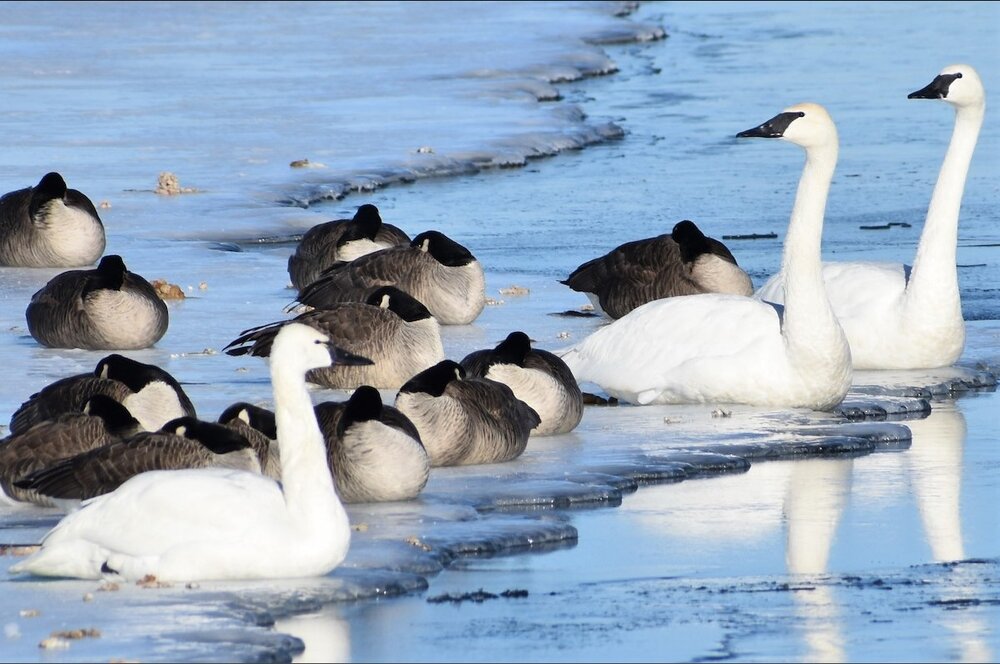



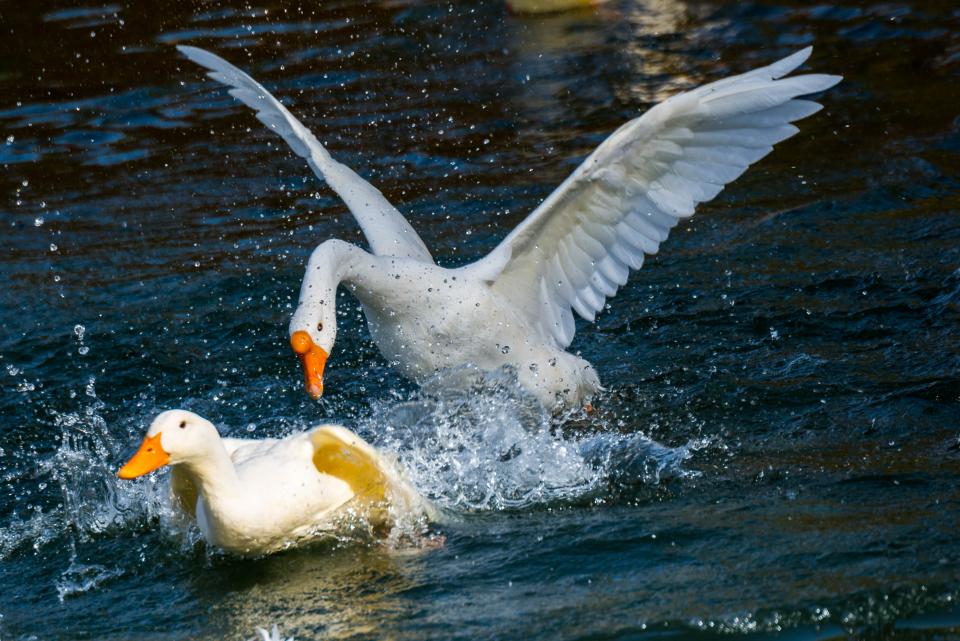



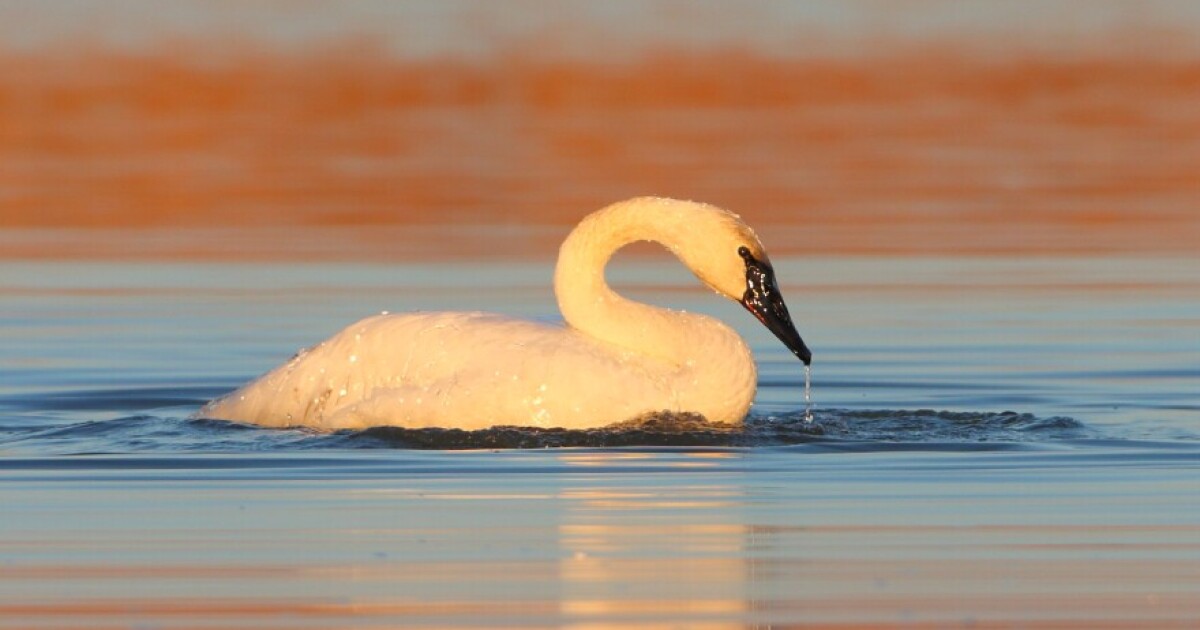

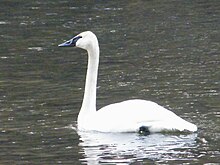








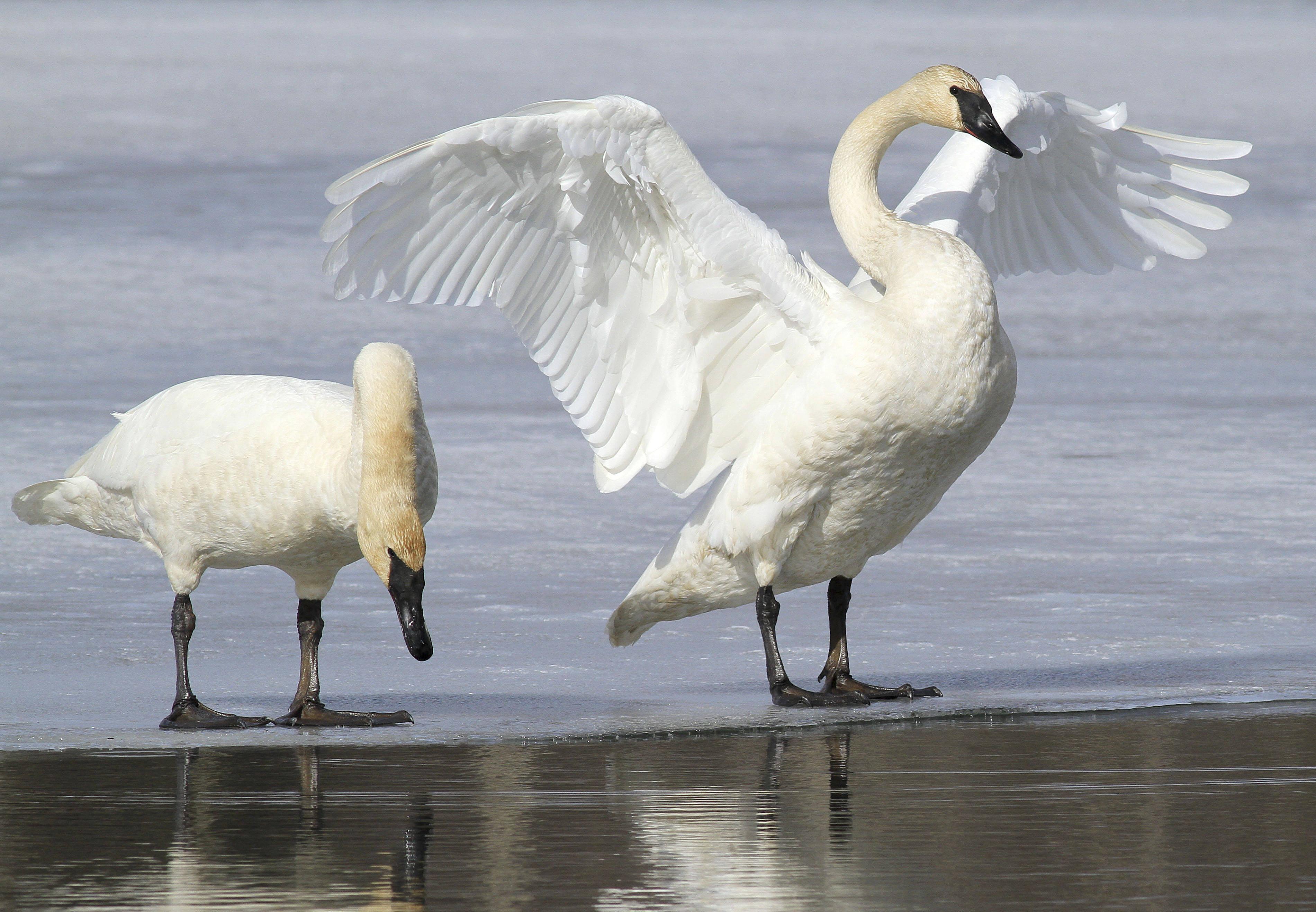
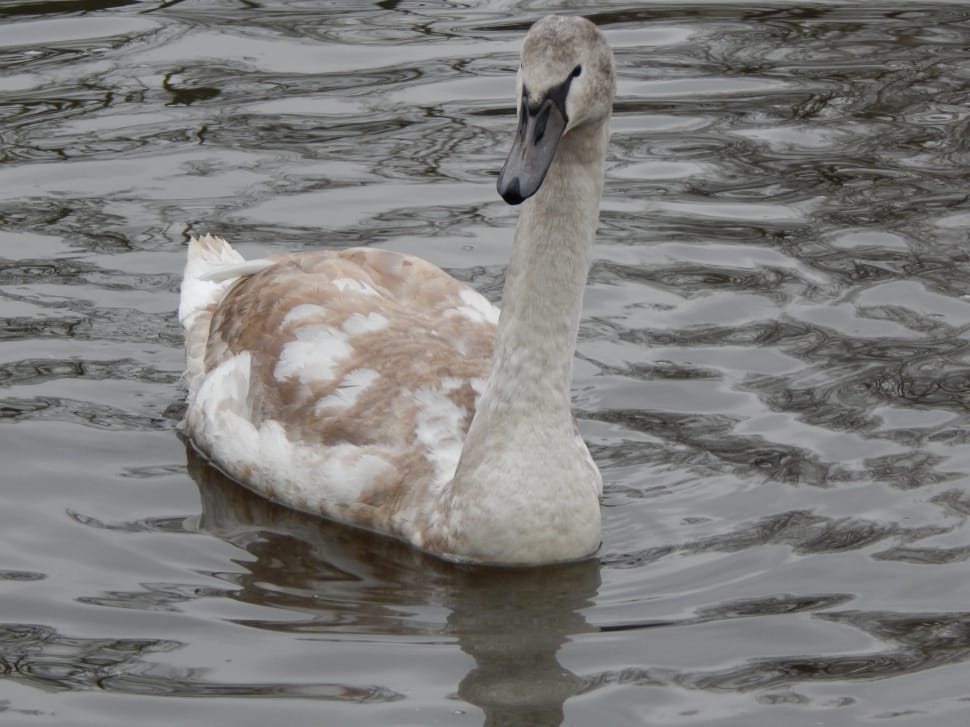


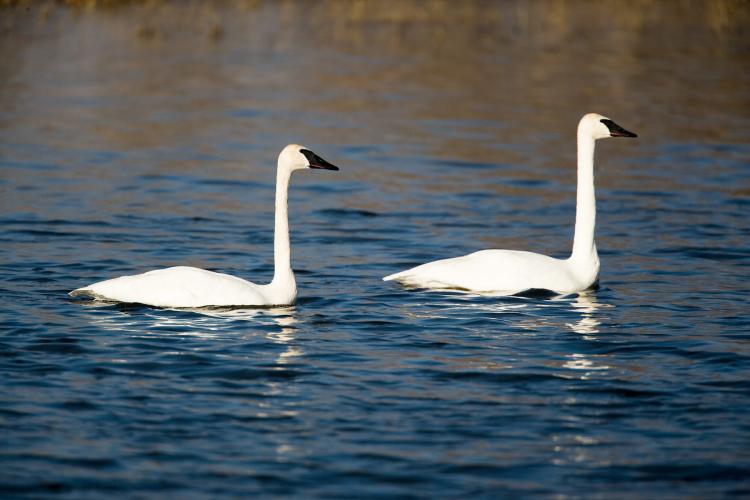


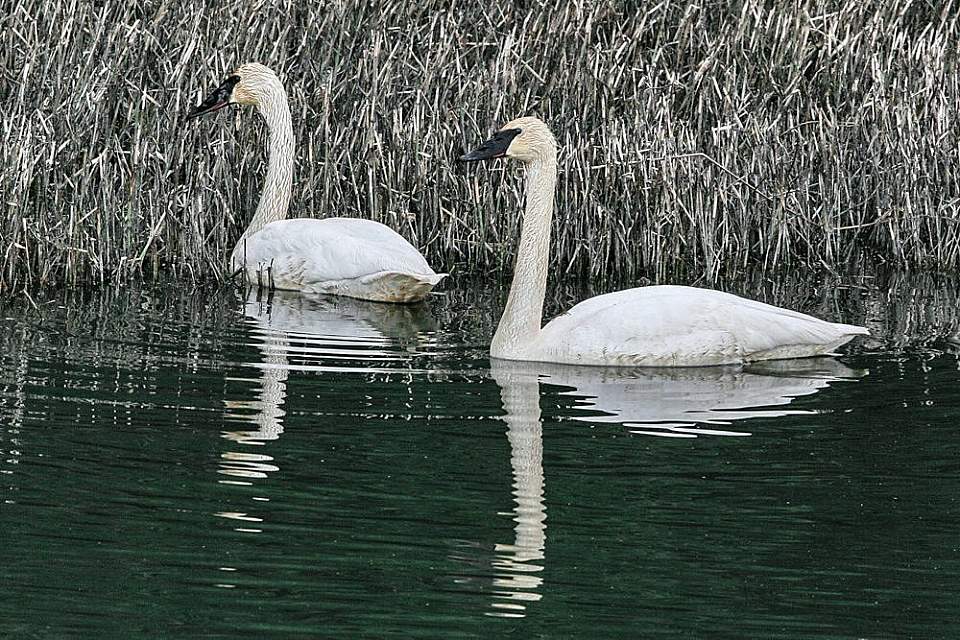


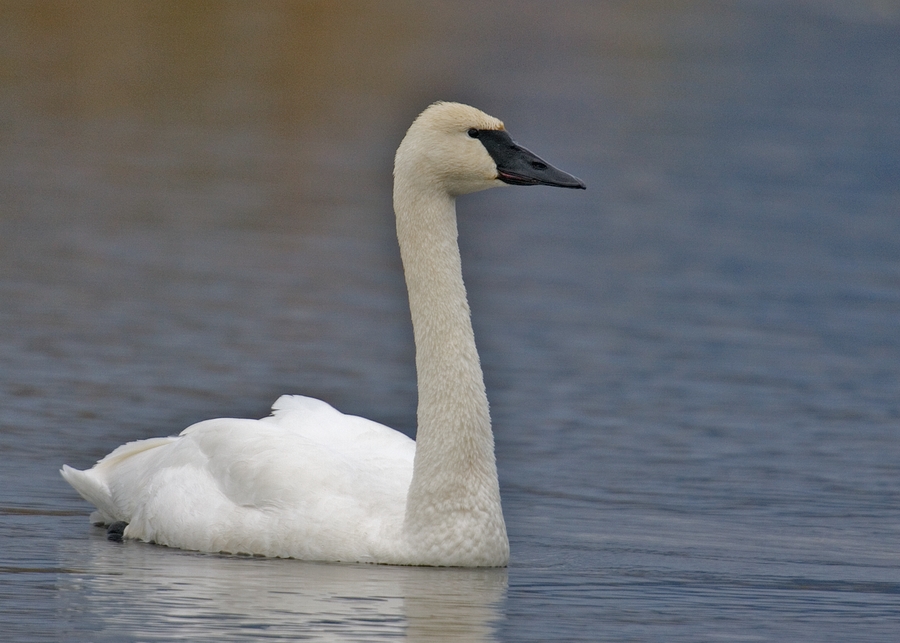

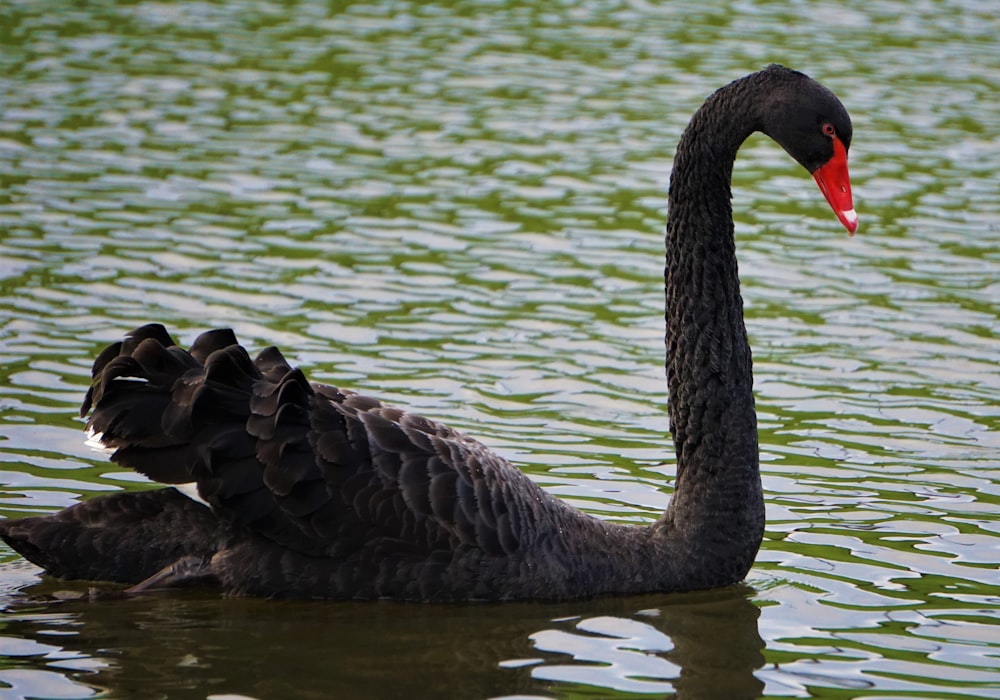

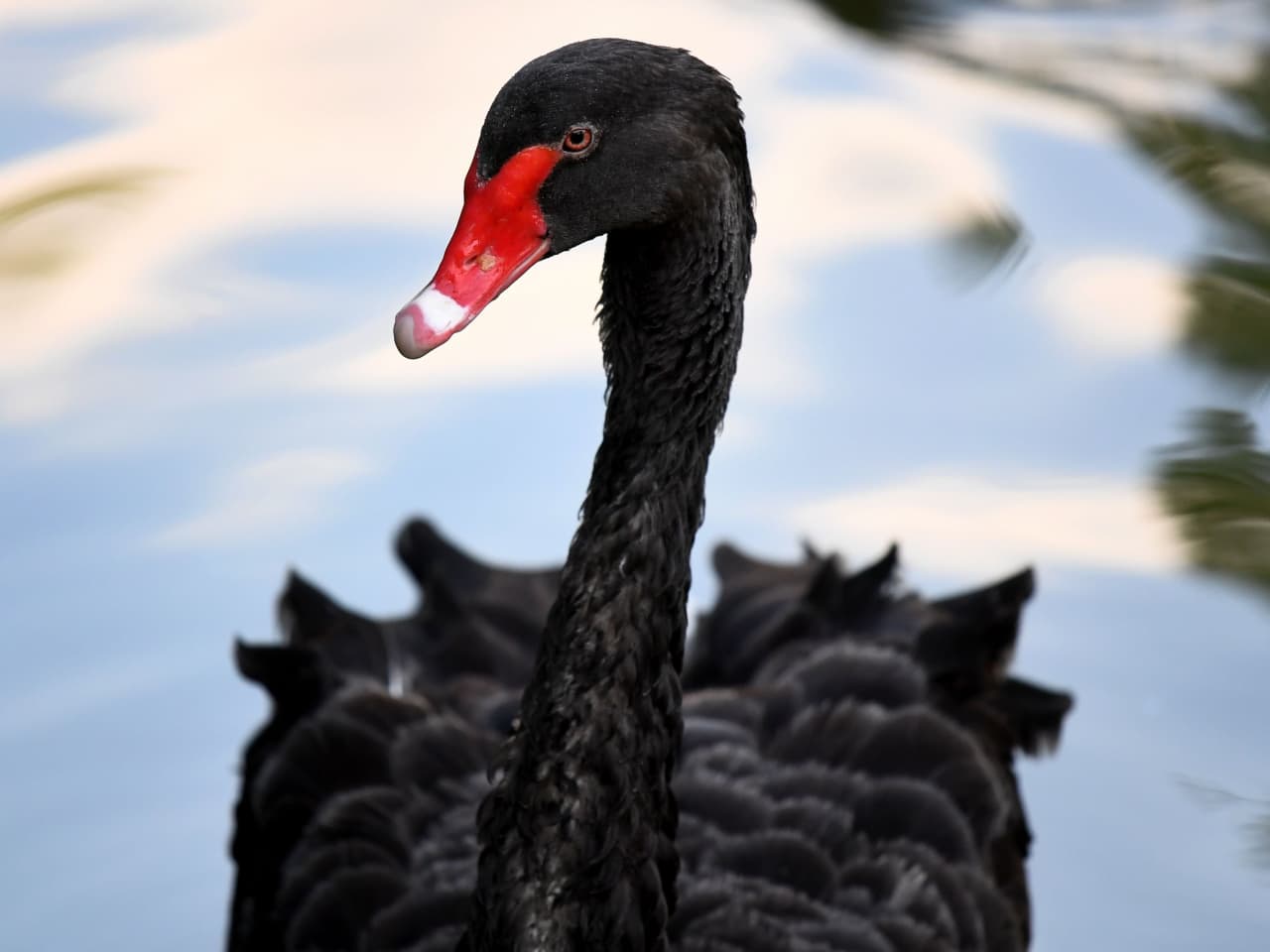
No comments:
Post a Comment
Note: Only a member of this blog may post a comment.